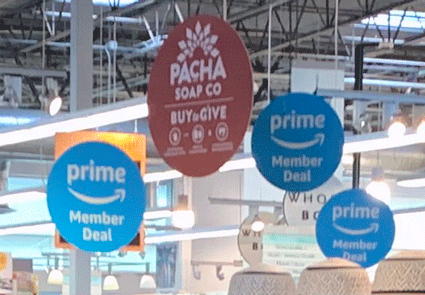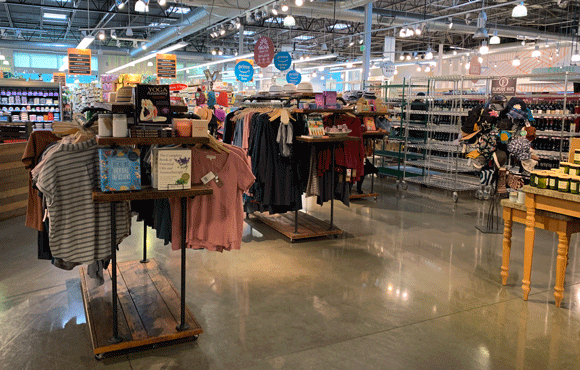Recent research has suggested that Amazon’s many private label brands are failing, but, as our chief strategy officer explains, the ecommerce juggernaut’s plan almost guarantees success for its house brands.
_______________________________________________________________________________________
By Brad Berens
 On Monday, a pair of Bloomberg articles by Spencer Soper surfaced a recent Jungle Scout study arguing that Amazon’s house brands aren’t selling well. For example, in apparel, “only one percent of Amazon’s total sales account for its private label brands.”
On Monday, a pair of Bloomberg articles by Spencer Soper surfaced a recent Jungle Scout study arguing that Amazon’s house brands aren’t selling well. For example, in apparel, “only one percent of Amazon’s total sales account for its private label brands.”
One of Soper’s articles, “Most Amazon Brands Are Duds, Not Disrupters, Study Finds,” ends in a telling way:
“Selling cheap batteries is very different than building brands,” Kaziukenas says. “Even when Amazon says ‘check out our own brands,’ consumers don’t know what it means and wonder why should they buy this thing they never heard of before.”
Kaziukenas is Juozas Kaziukenas, founder of Marketplace Pulse. The reason his statement is telling is that it reveals the approach analysts are taking focuses on where Amazon’s house brands are today rather than where they’re going to be tomorrow.
It’s instructive to remember that one of Amazon’s corporate slogans is, “it’s always day one.” Amazon’s strategy with its house brands is at the start of the first inning. Even if its house brands aren’t performing well today, Amazon always plays a long game. In its first investor letter, and many times since, founder CEO Jeff Bezos said, “We are willing to be misunderstood for long periods of time.”
A latent brand awareness ecosystem
To understand Amazon’s house brand strategy, it’s necessary to look at the company’s rapidly evolving passive awareness generating ecosystem, which includes:
-
- Amazon.com, the website most Americans turn to first when searching for product information
- Wholly-owned-by-Amazon book sites like Abebooks and Goodreads that feature ads for non-book products
- Audible, the audio book site
- ComiXology, the digital comic book site
- Cookie-driven ads where a product you’ve searched on Amazon follows you around the internet for days or weeks after
- Free Dive, the soon-to-launch, free, ad-supported streaming video network
- Twitch, the massive ad-supported e-sports network (non-gamers: take this seriously)
- The company’s aggressive investment in streaming live sports, including pro-football on Thursdays
- Whole Foods
- The Amazon Go robot bodegas
- A soon-to-launch, differently branded chain of grocery stores
- The potential to include brochures inside or on every Amazon box, every Prime Now delivery bag, every box of shoes delivered by Zappos
- And I’m sure that I’m missing other examples.
Amazon will use this ecosystem to make its house brands easily thinkable to the minds of its customers, so what Kaziukenas calls “this thing they never heard of before” will become “those things I’m comfortable with because I’ve seen them advertised everywhere.”
Passive awareness, or cognitive availability, means that a product is already latent in our minds even before we need to buy it. If we’re aware of a product—even though that awareness might have been entirely purchased by advertising—then, as behavioral economics teaches us, we’ll trust the product more than a competitor of which we’re less aware.
Passive awareness is necessary for brands, since brands are and always have been proxies for information and effort-saving substitutes for thinking.
Most of our purchases are simultaneously important and trivial. They’re important because we need stuff to get on with our lives: breakfast cereal, toothpaste, shoes, gas for the car, hair gel, blue jeans. They’re trivial because—with a few idiosyncratic exceptions where we actually care about a specific brand—we don’t care all that much about who makes the stuff so long as it’s of an acceptable quality and price. We want to think as little as possible about most of our purchases, so we rely on brands.
Brands advertise their ways into our awareness. Amazon is constructing a deep and interconnected set of ad-supported assets. Amazon can both make money from advertisers by selling some of that ad inventory and also promote awareness of its house brands by using some of that same ad inventory itself.
This is a win-win for Amazon and a win-today/lose-tomorrow for most other brands that will eventually find themselves competing with Amazon’s house brands, which the customer awareness ecosystem will favor.
Want proof? Drive to Whole Foods
Attentive readers might recall that in June of 2018, in “The half-life of brands: Amazon’s algorithmic strategy,” I argued that while Amazon’s purchase of Whole Foods made sense as a gateway into the lucrative grocery business, it makes even more sense if we regard Whole Foods as a massive generator of passive awareness for Amazon’s private label brands.
That was somewhat theoretical at the time, but the two Bloomberg articles inspired me to visit my local Whole Foods, where I saw an island of non-food items towards the back of the store:

The photo features clothes, books, soaps, candles, hats, a large display of Melissa and Doug wooden toys (towards the back), and empty racks waiting for more merchandise (off to the right).
Above, we see the biggest brand play of them all: the blue signs hanging from the ceiling that say, “Amazon Prime Member Deal.”
Don’t dismiss Amazon’s house brands because they aren’t selling well today. They’re just getting started.
__________

Brad Berens is the Center’s Chief Strategy Officer. He is also principal at Big Digital Idea Consulting.
See all columns from the Center.
March 20, 2019

